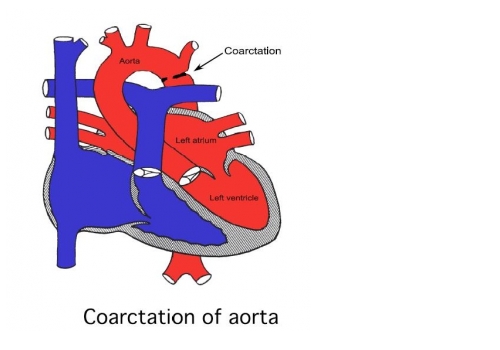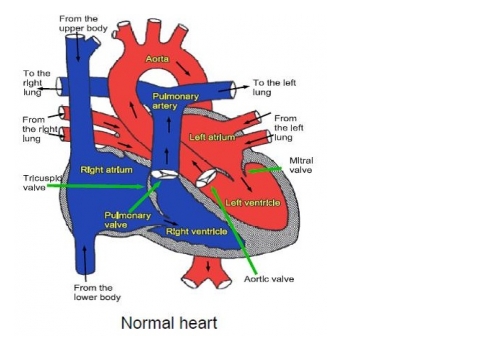Teen
- About
- Meet The Team
- Conditions
- Aortic Stenosis
- Atrial Septal Defect
- Coarctation of the Aorta
- Complete Atrioventricular Septal Defect
- Interrupted Aortic Arch
- Normal Heart
- Partial Atrio-Ventricular Septal Defect
- Patent Ductus Arteriosus
- Pulmonary Atresia with Intact Ventricular Septum
- Pulmonary Atresia with Ventricular Septal Defect
- Pulmonary Stenosis
- Small Ventricular Septal Defect (Muscular)
- Small Ventricular Septal Defect (Perimembraneous)
- Tetralogy of Fallot
- Transposition of the Great Arteries
- Ventricular Septal Defect (Large)
- Transition to Adult Congenital Cardiac Services
- Coming in to Hospital
- Surgery and Managing Your Discomfort
- Cardiac Catheter
- Ablation Procedure
- Pacemakers
- Looking after your oral health
- Lifestyle and Exercise Advice
- Periods, contraception and pregnancy
- Support
- Your Views
- Confidentiality and Consent
Coarctation of the Aorta
This is a serious heart condition in which there is a narrowing in the main artery (the aorta) which comes off the heart to feed the body with blood. The narrowing usually occurs just after the aorta has given off branches to supply the head and arms with blood, preventing normal circulation to the lower half of the body. In some patients the coarctation is not apparent early in life but gradually develops over time (sometimes weeks, sometimes years). The narrowing in the aorta makes it harder for the heart to pump and causes high blood pressure in the blood vessels in the head and the arms, so the muscle of the left sided pumping chamber (the left ventricle) becomes thickened and if the coarctation is not treated heart failure, stroke or death may eventually occur.
Here’s a video explaining about Coarctation
Here’s a video about the treatment of Coarctation


Tests
Initially simple tests such as an ultrasound scan of the heart (an “echocardiogram”), and an x-ray of the chest are required. Frequently a CT scan is required.
Treatment
Treatment is necessary to repair the coarctation. The narrowing can be repaired surgically (cutting out the narrowing and sewing the ends back together or using a patch of material to enlarge the narrowing), usually using a cut on the left side of the chest. In more complicated cases it may be necessary to use a cut down the middle of the front of the chest.
Some patients are suitable for “keyhole” treatment where the narrowing is stretched open with a balloon passed up from the artery at the top of the leg, or the narrowing is propped open using an expandable metal mesh tube (a stent) inserted from the artery at the top of the leg.
Risks of treatment
Most patients with coarctation of the aorta will survive treatment and go on to lead normal active lives, but there is a small risk (about 1 in 100) of dying at or shortly after treatment.
Complications such as stroke and internal bleeding may occur with either form of treatment but are also rare; kidney damage can occur but most patients recover from this. With surgery there is also a small risk (about 1 in 100) of damage to the spinal cord, which carries the nerves to the lower half of the body. Spinal cord damage is a very serious complication as it does not usually recover and the patient is left with paralysis.
Other abnormalities
Some children with coarctation will have other heart abnormalities such as a hole between the main pumping chambers or a narrow heart valve. If present, these other abnormalities sometimes don‘t need treatment early on in life but need to be watched as the baby grows.
Sometimes further surgery may be needed for such abnormalities later. Some patients with coarctation also have a chromosome abnormality. Tests for these are often performed routinely, particularly if the baby has more than one suspected abnormality. It can take some weeks to get the results of these tests.
Follow up after operation
When repair has been necessary during childhood sometimes the narrowing in the aorta can recur as time goes by, sometimes needing further treatment. Even many years after treatment it is possible to develop a weakness in the wall of the aorta (called an aneurysm), which can be serious and can also require further surgery. Even after a good result from treatment high blood pressure is common in later life. For all these reasons lifelong follow up is necessary.
Endocarditis
There is a small risk of infection occurring in the aorta or on one of the heart valves (called endocarditis). This can happen even years after the operation and can be caused by infection of the teeth or gums. It is very important to have good dental care and visit the dentist regularly (every 6-12 months). Infection can occur with ear and body piercing and tattooing and can sometimes lead to endocarditis, so these procedures are best avoided.
